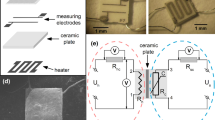Abstract
Issues like morphology control and further multifunctional applications are of significant importance for rare earth nano-oxides, e.g., cerium dioxide (CeO2) nanostructures, however, relevant results in this respect are rather limited up to now. In the present work, ultrathin CeO2 nanosheets were synthesized through a facile low-temperature hydrothermal method. The structure, morphology and specific surface area of these CeO2 nanosheets were characterized by X-ray diffraction (XRD), field emission scanning electron microscope (FESEM) and N2 adsorption–desorption. Significantly, CeO2 nanosheets have the potential as bifunctional sensing materials to detect both humidity and formaldehyde vapor. The CeO2 nanosheet humidity sensor exhibited excellent sensing characteristics in the relative humidity range of 11%–97% with the response value as high as 3.1 × 104. Meanwhile, the CeO2 nanosheet gas sensor showed superior sensitivity and repeatability with fast response/recovery speed toward formaldehyde vapor at 300 °C. Finally, the humidity and formaldehyde sensing mechanism were discussed as well.
Graphic abstract






Similar content being viewed by others
References
Montini T, Melchionna M, Monai M, Fornasiero P. Fundamentals and catalytic applications of CeO2-based materials. Chem Rev. 2016;116(10):5987.
Wu M, Zhang Y, Szeto W, Pan W, Huang H, Leung DYC. Vacuum ultraviolet (VUV)-based photocatalytic oxidation for toluene degradation over pure CeO2. Chem Eng Sci. 2019;200:203.
Si R, Flytzani-Stephanopoulos M. Shape and crystal-plane effects of nanoscale ceria on the activity of Au-CeO2 catalysts for the water-gas shift reaction. Angew Chem Int Edit. 2008;47(15):2884.
Sayle DC, Maicaneanu SA, Watson GW. Atomistic models for CeO2(111), (110), and (100) nanoparticles, supported on yttrium-stabilized zirconia. J Am Chem Soc. 2002;124(38):11429.
Ferraz NP, Nogueira AE, Marcos FCF, Machado VA, Rocca RR, Assaf EM, Asencios YJO. CeO2–Nb2O5 photocatalysts for degradation of organic pollutants in water. Rare Met. 2020;39(3):230.
Pang JH, Liu Y, Li J, Yang XJ. Solvothermal synthesis of nano-CeO2 aggregates and its application as a high efficient arsenic adsorbent. Rare Met. 2019;38(1):73.
Zito CA, Perfecto TM, Volanti DP. Porous CeO2 nanospheres for room temperature triethylamine sensor under high humidity condition. New J Chem. 2018;42:15954.
Hussain S, Aslam N, Yang XY, Javed MS, Xu ZW, Wang MS, Liu GW, Qiao GJ. Unique polyhedron CeO2 nanostructures for superior formaldehyde gas-sensing performances. Ceram Int. 2018;44(16):19624.
Zou W, Deng B, Hu X, Zhou Y, Pu Y, Yu S, Ma K, Sun JF, Wan HQ, Dong L. Crystal-plane-dependent metal oxide-support interaction in CeO2/g-C3N4 for photocatalytic hydrogen evolution. Appl Catal B Environ. 2018;238:111.
Zhang J, Kumagai H, Yamamura K, Ohara S, Takami S, Morikawa A, Shinjoh H, Kaneko K, Adschiri T, Suda A. Extra-low-temperature oxygen storage capacity of CeO2 nanocrystals with cubic facets. Nano Lett. 2011;11(2):361.
Grabchenko MV, Mamontov GV, Zaikovskii VI, La Parola V, Liotta LF, Vodyankina OV. The role of metal-support interaction in Ag/CeO2 catalysts for CO and soot oxidation. Appl Catal B Environ. 2020;260:16.
Huang WX, Gao YX. Morphology-dependent surface chemistry and catalysis of CeO2 nanocrystals. Catal Sci Technol. 2014;4(11):3772.
Wang DY, Kang YJ, Doan-Nguyen V, Chen J, Kungas R, Wieder NL, Bakhmutsky K, Gorte RJ, Murray CB. Synthesis and oxygen storage capacity of two-dimensional ceria nanocrystals. Angew Chem Int Edit. 2011;50(19):4378.
Cao T, You R, Li ZR, Zhang XY, Li D, Chen SL, Zhang ZH, Huang WX. Morphology-dependent CeO2 catalysis in acetylene semihydrogenation reaction. Appl Surf Sci. 2020;501:13.
Tan HY, Wang J, Yu SZ, Zhou KB. Support morphology-dependent catalytic activity of Pd/CeO2 for formaldehyde oxidation. Environ Sci Technol. 2015;49(14):8675.
Sun CW, Li H, Chen LQ. Nanostructured ceria-based materials: synthesis, properties, and applications. Energy Environ Sci. 2012;5(9):8475.
Zhang DS, Fu HX, Shi LY, Fang JH, Li Q. Carbon nanotube assisted synthesis of CeO2 nanotubes. J Solid State Chem. 2007;180(2):654.
Padmanathan N, Selladurai S. Shape controlled synthesis of CeO2 nanostructures for high performance supercapacitor electrodes. RSC Adv. 2014;4(13):6527.
Yu H, Yang TY, Zhao R, Xiao BX, Li ZF, Zhang MZ. Fast formaldehyde gas sensing response properties of ultrathin SnO2 nanosheets. RSC Adv. 2015;5(126):104574.
Xu R, Zhang LX, Li MW, Yin YY, Yin J, Zhu MY, Chen JJ, Wang Y, Bie LJ. Ultrathin SnO2 nanosheets with dominant high-energy 001 facets for low temperature formaldehyde gas sensor. Sens Actuat B Chem. 2019;289:186.
Sun YF, Liu QH, Gao S, Cheng H, Lei FC, Sun ZH, Jiang Y, Su HB, Wei SQ, Xie Y. Pits confined in ultrathin cerium (IV) oxide for studying catalytic centers in carbon monoxide oxidation. Nat Commun. 2013;4:2899.
Xu J, Chen XY, Xu YS, Du YP, Yan CH. Ultrathin 2D rare-earth nanomaterials: compositions, syntheses, and applications. Adv Mater. 2020;32(3):1806461.
Thakur S, Patil P. Rapid synthesis of cerium oxide nanoparticles with superior humidity-sensing performance. Sens. Actuat B Chem. 2014;194:260.
Wang C, Wang Y. Effects of different surfactants on humidity sensing properties of CeO2 nanobelts thin film prepared by hydrothermal method. Int J Appl Ceram Technol. 2015;12:E142.
Poonia E, Mishra PK, Kiran V, Sangwan J, Kumar R, Rai PK, Malik R, Tomer VK, Ahuja R, Mishra YK. Aero-gel based CeO2 nanoparticles: synthesis, structural properties and detailed humidity sensing response. J Mater Chem C. 2019;7:5477.
Wang D, Yin Y, Xu P, Wang F, Wang P, Xu J, Wang X, Li X. Catalytic-induced sensing effect of triangular CeO2 nanoflakes for enhanced BTEX vapor detection with conventional ZnO gas sensors. J Mater Chem A. 2020;8:11188.
Pandeeswari R, Jeyaprakash BG. CeO2 thin film as a low-temperature formaldehyde sensor in mixed vapour environment. Bull Mater Sci. 2014;37(6):1293.
Wan K, Wang D, Wang F, Li H, Xu J, Wang X, Yang J. Hierarchical In2O3@SnO2 core–shell nanofiber for high efficiency formaldehyde detection. ACS Appl Mater Interfaces. 2019;11(48):45214.
Su C, Zhang L, Han Y, Chen X, Wang S, Zeng M, Hu N, Su Y, Zhou Z, Wei H, Yang Z. Glucose-assisted synthesis of hierarchical flower-like Co3O4 nanostructures assembled by porous nanosheets for enhanced acetone sensing. Sens Actuat B Chem. 2019;288:699.
Su C, Zhang L, Han Y, Ren C, Chen X, Hu J, Zeng M, Hu N, Su Y, Zhou Z, Yang Z. Controllable synthesis of crescent-shaped porous NiO nanoplates for conductometric ethanol gas sensors. Sens Actuat B Chem. 2019;296:126642.
Han Y, Ma Y, Liu Y, Xu S, Chen X, Zeng M, Hu N, Su Y, Zhou Z, Yang Z. Construction of MoS2/SnO2 heterostructures for sensitive NO2 detection at room temperature. Appl Surf Sci. 2019;493:613.
Yuan Z, Han E, Meng F, Zuo K. Detection and identification of volatile organic compounds based on temperature-modulated ZnO sensors. IEEE T Instrum Meas. 2020;69(7):4533.
Liu L, Zhang C, Zhang LX, Li Q, Yin YY, Wang HY, Sun RH, Li JY, Hou XY, Dong H, Bie LJ. A 2D coordination polymer of [Cd(TMA)(4-CNPy)(H2O)]n (H2TMA = 3-thiophenemalonic acid, 4-CNPy = 4-cyanopyridine) with impedimetric humidity sensing performance. Inorg Chem Commun. 2020;111:107636.
Qiao PY, Zhang LX, Zhu MY, Yin YY, Zhao ZW, Sun HN, Dong JY, Bie LJ. Acetylene sensing enhancement of mesoporous ZnO nanosheets with morphology and defect induced structural sensitization. Sens Actuat B Chem. 2017;250:189.
Alghouti MA, Da’ana DA. Guidelines for the use and interpretation of adsorption isotherm models: a review. J Hazard Mater. 2020;393:22.
Yu SG, Zhang HY, Chen C, Lin CC. Investigation of humidity sensor based on Au modified ZnO nanosheets via hydrothermal method and first principle. Sens Actuat B Chem. 2019;287:526.
Wang Z, Lu Y, Yuan S, Shi L, Zhao Y, Zhang M, Deng W. Hydrothermal synthesis and humidity sensing properties of size-controlled zirconium oxide (ZrO2) nanorods. J Colloid Interface Sci. 2013;396:9.
Zhang DZ, Liu JJ, Xia BK. Layer-by-layer self-assembly of zinc oxide/graphene oxide hybrid toward ultrasensitive humidity sensing. IEEE Electr Device L. 2016;37(7):916.
Song HJ, Yan SW, Yao YL, Xia LX, Jia XH, Xu JS. 3D α-Fe2O3 nanorods arrays@graphene oxide nanosheets as sensing materials for improved gas sensitivity. Chem Eng J. 2019;370:1331.
Ma JW, Fan HQ, Zhang WM, Sui JN, Wang C, Zhang MC, Zhao N, Yadav AK, Wang WJ, Dong WQ, Wang SR. High sensitivity and ultra-low detection limit of chlorine gas sensor based on In2O3 nanosheets by a simple template method. Sens Actuat B Chem. 2020;305:127456.
Chen T, Liu QJ, Zhou ZL, Wang YD. The fabrication and gas-sensing characteristics of the formaldehyde gas sensors with high sensitivity. Sens Actuat B Chem. 2008;131(1):301.
Acknowledgements
This work was financially supported by the National Natural Science Foundation of China (Nos. 21601094 and 21401139), the Natural Science Foundation of Tianjin City (Nos. 15JCQNJC02900 and 18JCQNJC73900) and Tianjin Municipal Education Commission (No. 2018KJ130).
Author information
Authors and Affiliations
Corresponding authors
Rights and permissions
About this article
Cite this article
Zhang, P., Zhang, LX., Xu, H. et al. Ultrathin CeO2 nanosheets as bifunctional sensing materials for humidity and formaldehyde detection. Rare Met. 40, 1614–1621 (2021). https://doi.org/10.1007/s12598-020-01619-7
Received:
Revised:
Accepted:
Published:
Issue Date:
DOI: https://doi.org/10.1007/s12598-020-01619-7




